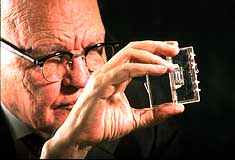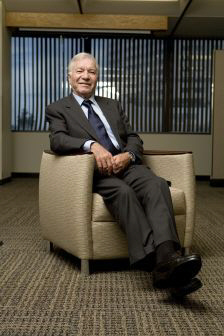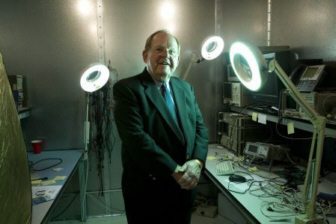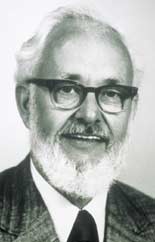
DATAMATH CALCULATOR MUSEUM
 |
DATAMATH CALCULATOR MUSEUM |
 There are few living men whose insights and professional
accomplishments have changed the world. Jack Kilby is one of these men. His invention of the
monolithic integrated circuit - the microchip - some 30 years ago at Texas
Instruments (TI) laid the conceptual and technical foundation for the entire field of modern
microelectronics. It was this breakthrough that made possible the sophisticated high-speed computers and large-capacity
semiconductor memories of today's information age.
There are few living men whose insights and professional
accomplishments have changed the world. Jack Kilby is one of these men. His invention of the
monolithic integrated circuit - the microchip - some 30 years ago at Texas
Instruments (TI) laid the conceptual and technical foundation for the entire field of modern
microelectronics. It was this breakthrough that made possible the sophisticated high-speed computers and large-capacity
semiconductor memories of today's information age.
Mr. Kilby grew up in Great Bend, Kansas. With B.S. and
M.S. degrees in electrical engineering from the Universities of Illinois and Wisconsin
respectively, he began his career in 1947 with the Centralab Division of Globe Union Inc. in Milwaukee, developing
ceramic-base, silk-screen circuits for consumer electronic products.
In 1958, he joined TI in Dallas. During the summer of that year
working with borrowed and improvised equipment, he conceived and built the first electronic circuit in which all of the
components, both active and passive, were fabricated in a single piece of semiconductor material half the size of a paper clip. The successful
laboratory demonstration of that first simple microchip on September 12, 1958, made history.
Jack Kilby went on to pioneer military, industrial, and commercial
applications of microchip technology. He headed teams that built both the first military system and the first computer incorporating
integrated circuits. He later co-invented both the hand-held calculator and the thermal printer that was used in portable data
terminals.
 In 1970, he took a leave of absence from TI to work as an
independent inventor exploring, among other subjects, the use of silicon technology for generating electrical power from
sunlight. From 1978 to 1984, he held the position of Distinguished Professor of Electrical Engineering at
Texas A&M University. At
present, he maintains a schedule of work and travel on industry and government consulting assignments throughout the
world. He also serves as director of several corporations.
In 1970, he took a leave of absence from TI to work as an
independent inventor exploring, among other subjects, the use of silicon technology for generating electrical power from
sunlight. From 1978 to 1984, he held the position of Distinguished Professor of Electrical Engineering at
Texas A&M University. At
present, he maintains a schedule of work and travel on industry and government consulting assignments throughout the
world. He also serves as director of several corporations.
Jack Kilby is the recipient of three of the nation's most prestigious
honors in science and engineering. In 1970, in a White House ceremony, he received the National Medal of Science. In 1982,
he was inducted into the National Inventors Hall of Fame, taking his place alongside Henry Ford, Thomas Edison, and the Wright
Brothers in the annals of American innovation. And finally, in
2000 the Nobel Prize for Physics was awarded to industry pioneer Jack Kilby.
Mr. Kilby holds over 60 U.S. patents. He is a Fellow of the
Institute of Electrical and Electronics Engineers (IEEE) and a member of the National Academy of Engineering (NAE). He has
been awarded the Franklin Institute's Stuart Ballantine Medal, the NAE's Vladimir Zworykin Award, the American Society of
Mechanical Engineers' Holley Medal, and the IEEE's Metal of Honor, Cledo Brunetti Award, and David Sarnoff Award. On the
30th anniversary of the invention of the integrated circuit, the Governor of Texas dedicated an official Texas historical marker
near the site of the TI laboratory where Mr. Kilby did his work.
    |
Jerry Merryman, a self-taught electrical engineer who helped design the first pocket calculator, died on Feb. 27 in Dallas. He was 86. His wife, Phyllis (Lee) Merryman, said the cause was heart and kidney failure. He had been hospitalized since late December for complications arising from surgery to install a pacemaker. In 1965, two years after he joined the electronics maker Texas Instruments without a college degree, the company asked Mr. Merryman and two other engineers to build a calculator that could fit into a shirt pocket. He designed the fundamental circuitry in less than three days, and when Texas Instruments unveiled the device two years later, the moment marked a transformational shift in the way Americans would handle everyday mathematics for the next four decades. “Silly me, I thought we were just making a calculator, but we were creating an electronic revolution,” Mr. Merryman told the NPR program “All Things Considered” in 2013. With this device, Mr. Merryman and his collaborators, Jack Kilby and James Van Tassel, also pioneered rechargeable batteries and “thermal printing,” which used heat to print numbers onto a special kind of paper. Speaking with NPR, Mr. Merryman said he was reminded of their work whenever he used a cellphone or was handed a thermally printed receipt by a grocery store cashier. Their Texas Instruments prototype, code-named Cal-Tech, is now enshrined at the Smithsonian Institution, tucked between the work of Thomas Edison and Alexander Graham Bell. Jerry Dale Merryman was born on June 17, 1932, at his family’s home outside Hearne, TX, an old railroad town 150 miles south of Dallas. His mother died two days later. His father, a railroad worker, was forced to retire in the 1950s after going blind from complications of diabetes. By the time he was 11, Jerry was working for the local appliance store, repairing radios. According to family lore, Hearne police officers would hunt him down whenever their car radios broke — no matter the time of day. He learned the ins and outs of electronics from a book he picked up at the appliance store — “Radio Engineering,” by Frederick Terman — and he held onto it for the next 75 years. “He read it all his life,” his wife said. After a stint with the railroad — he packed ice into refrigerator cars carrying bananas — Mr. Merryman worked as an engineer at a local radio station. Then, in the late 1950s, he enrolled at Texas A&M University in nearby College Station. He left without finishing his degree. In March 1963, he applied for an engineering job at Texas Instruments, near Dallas, and was hired without the traditional qualifications. “That was one of the smartest things the company ever did,” Ed Millis, who joined the company in the early ’50s and worked alongside Mr. Merryman for decades, said in a telephone interview. Mr. Merryman immediately joined a team that was developing what were called integrated circuits, the breed of microchip that would later drive personal computers. His boss was Mr. Kilby, who had helped build the first integrated circuit in 1958. (Mr. Kilby, who later shared the 2000 Nobel Prize in Physics for this work. died in 2005.) Seven years later, these microchips had yet to find their market niche, and Texas Instruments’ president at the time, Patrick E. Haggerty, decided that the company needed to prove its worth with a consumer product. He called for a pocket calculator. Mr. Merryman was pulled into the project at the end of 1965, when he was summoned to a meeting in Mr. Kilby’s office. There, Mr. Kilby held up a small book and asked for a computer that size. Years later, when a friend mentioned that Mr. Merryman had designed the calculator’s circuitry in only three days, Mr. Merryman leaned toward him and said, “And three nights.” He, Mr. Kilby and Mr. Van Tassel initially built a prototype, which spanned an entire room at their Texas Instruments lab. Then, over the next two years, they packed the same circuit design into a hand-held casing using microchips. The device had 18 keys, and it could handle addition, subtraction, multiplication and division, printing calculations on a tiny spool of paper. It reached the market in 1970 after Texas Instruments licensed the technology to Canon, carrying a $400 price tag. Soon a second partner, Bowmar, introduced a $250 version called the Bowmar Brain. Over the next few decades, these devices got smaller and prices continued to drop, and the pocket calculator became a nearly ubiquitous household item. It lost its place in American homes only after the arrival of the Apple iPhone and other smartphones a decade ago. In addition to his wife, Mr. Merryman is survived by his daughter, Melissa Merryman; his stepdaughter, Kim Ikovic; and two granddaughters. His two previous wives, Vernette (Posey) and Sally (Simon) Merryman, died before him. During his brief stint at Texas A&M, Mr. Merryman entered a contest alongside 600 other students. They competed to see who was best at using a slide rule, the wood and plastic device that helped with multiplication, division, trigonometry and other mathematical calculations. After buying a used slide rule for $6, Mr. Merryman won the contest with a nearly perfect score. “Hearne Student ‘Pulverized ′em’ in A&M Contest,” the headline in the local paper read. Just a few years later, he helped make the slide rule obsolete. By Cade Metz, a technology correspondent with The New York Times. Thank you! |
 Jerry D. Merryman joined TI in 1963 and remained with the company for 30 years. He was one of three team members responsible for the invention of the handheld electronic calculator, and served as project manager and logic designer for the two-year project.
Jerry D. Merryman joined TI in 1963 and remained with the company for 30 years. He was one of three team members responsible for the invention of the handheld electronic calculator, and served as project manager and logic designer for the two-year project.
In his career with TI, Merryman worked as an engineer in the design and development of a variety of products and technologies. In addition to his work on the handheld calculator, Merryman was instrumental in designing and fabricating semiconductor manufacturing equipment. He also made significant contributions to the thermal printing devices that TI used for years in a popular family of data terminal products.
Elected a TI Fellow in 1975, Merryman worked in the area of industrial automation, including the application of optics and electronics to a family of high-speed laser writers used in submicron optical lithography.
Merryman began his career at the Texas A&M Department of Oceanography and Meteorology measuring the force of hurricane winds and oceans on an oil platform in the Gulf of Mexico. It was while working at A&M that Merryman designed a mobile meteorological data-gathering station, which included building his first computer.
Merryman retired in 1993, but remained for a few years an active consultant. He holds approximately 60 U.S. and foreign patents.
 James H. Van Tassel joined Texas Instruments in 1960, and remained with the company for nearly 20 years. He was one of three team members responsible for the invention of the handheld electronic calculator, and developed the compact keyboard and device packaging for the prototype.
James H. Van Tassel joined Texas Instruments in 1960, and remained with the company for nearly 20 years. He was one of three team members responsible for the invention of the handheld electronic calculator, and developed the compact keyboard and device packaging for the prototype.
At TI, Dr. Van Tassel served as director of process control and quality laboratories at TI’s semiconductor manufacturing operations from 1967 to 1972. Much of his early work at Texas Instruments involved the development of magnetic thin memory film. He became technical director of TI Europe in 1972 and was responsible for engineering management and development there. Dr. Van Tassel returned to the United States in 1975 and held several positions with Texas Instruments in Houston, including manager of the MOS Logic Business Unit.
Following his time at Texas Instruments, Dr. Van Tassel joined NCR Corporation in 1980 and served as Vice President of the Microelectronics Division until 1991. While at NCR, Dr. Van Tassel was responsible for the development and manufacture of semiconductors.
Dr. Van Tassel holds a Bachelor of Science from the University of Wisconsin at LaCrosse, a Master of Chemistry and a Doctor of Philosophy in Chemistry from Texas Technological University. He also completed post-doctoral study in analytical instrumentation at Princeton University. He currently resides in Dayton, Ohio.
 Pat Haggerty, business executive, son of Michael Eugene and Lillian
(Evenson) Haggerty, was born at Harvey, North Dakota, on March 17, 1914. He married Beatrice E. Menne on February 26, 1938; they had five children. At an early age
Haggerty built a prize-winning radio and became one of the first ham radio operators in North Dakota. He entered Marquette University in 1931
with a scholarship and worked part-time at the Badger Carton Company, Milwaukee. After graduating summa cum laude from the Marquette
University School of Electrical Engineering in 1936, he became a full-time production manager at Badger. A year later he was given responsibility
for all engineering, manufacturing, and administrative functions at Badger except sales. In World War II,qv Haggerty, an ensign in the United States
Naval Reserve, served in the Bureau of Aeronautics, Department of the Navy, Washington, D.C. Initially, he evaluated the performance of
manufacturers supplying electronic equipment to the United States Navy; he was later given responsibility for all procurement and
production of naval airborne electronic equipment and progressed to the rank of lieutenant.
Pat Haggerty, business executive, son of Michael Eugene and Lillian
(Evenson) Haggerty, was born at Harvey, North Dakota, on March 17, 1914. He married Beatrice E. Menne on February 26, 1938; they had five children. At an early age
Haggerty built a prize-winning radio and became one of the first ham radio operators in North Dakota. He entered Marquette University in 1931
with a scholarship and worked part-time at the Badger Carton Company, Milwaukee. After graduating summa cum laude from the Marquette
University School of Electrical Engineering in 1936, he became a full-time production manager at Badger. A year later he was given responsibility
for all engineering, manufacturing, and administrative functions at Badger except sales. In World War II,qv Haggerty, an ensign in the United States
Naval Reserve, served in the Bureau of Aeronautics, Department of the Navy, Washington, D.C. Initially, he evaluated the performance of
manufacturers supplying electronic equipment to the United States Navy; he was later given responsibility for all procurement and
production of naval airborne electronic equipment and progressed to the rank of lieutenant.
During this period he met J. Erik Jonsson of Geophysical Service, Incorporated, now Texas Instruments, Incorporated.qv GSI, founded in 1930 as
Geophysical Service, was the first independent contractor specializing in the reflection-seismograph method of geophysical exploration. It was found
that similar techniques could be used to locate submerged submarines, and in 1942 the company began building electronic systems for military
use. Jonsson and Haggerty talked of the need after the war for a good, small company to combine electrical and mechanical technology for innovative
military and civilian products. Haggerty joined GSI in Dallas in November 1945 as general manager of the newly formed Laboratory and
Manufacturing Division, with responsibility for developing the research, engineering, and manufacturing phases of the company's
operations. Manufactured products gradually overtook services in sales volume, and in December 1951 GSI became Texas Instruments, Incorporated. Haggerty
became executive vice president and director in 1951, president in 1958, and chairman in 1967, a post he held until retiring. For TI to be a significant
electronics company, Haggerty believed that it was necessary to do more than assemble components. When Western Electric offered to sell
licenses for the manufacture of transistors in 1951, Haggerty seized the opportunity to provide components that would replace bulky vacuum
tubes, such as those used in radios. Within months TI had its first transistor, and by the latter part of 1953 the firm was mass-producing germanium
transistors under the direction of Mark Shepherd, Jr. Initial prices were high, however, and Haggerty sought a
high-volume manufacturing base to lower costs and produce ongoing demand. He decided that the portable-radio market would stimulate demand, and the pocket-sized Regency radio
was introduced just in time for Christmas, 1954. Thus began a new era in electronics technology. That same year TI pioneered commercial
production of transistors made from silicon, a material that could withstand high operating temperatures occurring in more complex, sophisticated
systems such as computers. Haggerty believed that electronics could benefit all parts of society, and discussions led to the hiring of research
engineers to explore the possibilities. One of these engineers, Jack Kilby, invented the integrated circuit in TI laboratories in 1958.
Other major achievements of TI under Haggerty's leadership included the development of new military
technologies in laser guidance, infrared night-vision equipment and airborne radars; the invention of the electronic hand-held calculator; the development of the thermal printhead, which
made possible a family of data terminals with silent printers; the invention of the single-chip microprocessor, the "brain" of a wide range of electronic
devices; the practical application of information theory to seismic data processing through development of digital techniques for recording and
processing geophysical data; the evolution of a widely studied management system (Objectives, Strategies, and Tactics) for managing the process of
technological innovation; and consistent improvements in productivity that permitted steady price reductions in the face of
increasing inflation.
Deeply concerned with the challenge to increase United States productivity, Haggerty made significant contributions to the literature on this issue. In
1974 he delivered a series of lectures on productivity to the Graduate School of Industrial Administration of Carnegie-Mellon University, and he
addressed the American Productivity Center and various professional associations to recommend solutions to America's "productivity malaise."
Throughout his career he encompassed the full range of scientific and technical achievement. His work inspired many vital contributions to the
electronics revolution.
He was a Catholic. He died on October 1, 1980, in Dallas, and was buried in Calvary Hill
Cemetery.
Richard M. Perdue Copyright ©, The Texas State Historical Association, 1997-2001
If you have additions to the above article please email: joerg@datamath.org.
© Texas Instruments Incorporates. Dallas